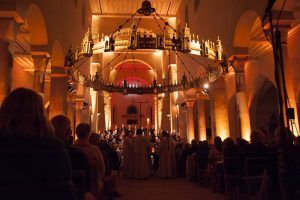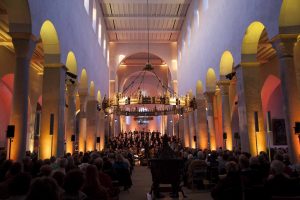Critic’s Picks… Lux in Tenebris: Oratorium aus Klang, Text und Licht
By T. J. Harper, D. M. A., choral conductor and teacher
Lux in Tenebris: Oratorium aus Klang, Text und Licht
Helge Burggrabe, Composer
Hildesheimer Dommusik: Domchor, Kammerchor, Mädchenkantorei and Schola Gregoriana;
Dommusikdirektor Thomas Viezens and Domkantor Stefan Mahr
Hildesheim Cathedral, Hildesheim, Germany
(2015; Music: 118’ 31”; Film: 30’; Photo Stream: 7’)
http://www.domshop-hildesheim.de/CD/DVD-Set-Lux-in-tenebris
Composed in celebration and honor of the 1200th anniversary of the Hildesheim diocese in Hildesheim, Germany, Lux in Tenebris (Light in the Dark), tells of the fall into darkness and the search for new light. This is the name of the new oratorio by composer Helge Burggrabe and is a tribute to this famous cathedral, which consists of music, text, and light. At the center of this oratorio stand the conflict of warfare and the hope of a new beginning. To honor the memory of Hildesheim Cathedral, this work places the bombing of March 22, 1945, which completely destroyed the cathedral, at the center of inspiration, sadness, and hope. The fundamental question of the composition can perhaps be seen through the idea of the biblical drama of Cain and Abel: Can the brother truly see the brother and can the sister truly see the sister?
The five-part Lux in Tenebris, also affectionately referred to as the Oratorio for Peace and Reconciliation, has at its foundation a new libretto by journalist Angela Krumpen and the Hildesheime theologian Dr. Reinhard Göllner. A primary concept for this work was that the idea of “Light” would be personified within the libretto. The libretto, which spans a broad arc, also deals with the destruction and rebuilding of the Hildesheimer Cathedral. Additionally, the famous Hildesheim art work, the bronze Bernward Doors from the early 11th century, play a significant role. Depicting scenes from the Old and New Testaments on the left and right side of the Bernward Doors, Lux in Tenebris tells of the fall into darkness and the search for new light that include biblical scenes from the creation of Adam and Eve, their expulsion from paradise, the murder of Abel, and the birth and activity of Jesus Christ through his resurrection. These events relate to reflections on the spiritual dimension of light and darkness.
The Bernward Doors (c. 1015) depict scenes from the Book of Genesis (left door) arranged in parallel to scenes from the Gospels (right door). The scenes are organized based on the principle that Adam and Christ mirror each other – with Christ’s sacrificial death redeeming Adam’s sin. The left door, from top to bottom, depicts the increasing estrangement of humanity from God: the Creation, the Fall, and Cain’s murder of Abel. The right door shows the redemptive work of Christ from bottom to top: the Annunciation and Nativity, the Passion, and the Resurrection. The Hildesheim Cathedral is a Romanesque construction built sometime between 1010 and 1020 that has been listed as a UNESCO Heritage Site since 1985. The cathedral was completely destroyed in the bombing on March 22, 1945. And like all the works of Helge Burggrabe, this work is also an overall composition of architecture, video art, light art, lyricism, and music.
Stylistically, the composition spans a wide range of Gregorian-like vocal lines, melodic vocal solos, large-scale eight-voice choral settings, voice chords, and atonal sounds. The multi-layered and differentiated music with each note serves the complex themes of the spiritual subtext. The performing forces are led by conductors Thomas Viezens and Stefan Mahr. Burggrabe’s contemporary tonal music also serves the Gregorian chorale and the sound language of Carl Orff or Alban Berg. The solo vocalists Geraldine Zeller (Eva), Anne Bierwirth (angel), Manuel König (light voice), and Stephan Freiberger (Adam) are particularly adept at capturing the emotion and depths of meaning in their performances. One of the significant movements within this grand work is the central chorus “Destruction I”. Here the Cain and Abel drama is related to the destruction of Hildesheim Cathedral. Despite all the drama, Burggrabe succeeds in making a subtle hopeful undertone resonate even in the most threatening sequences. He is supported by the poem-declamations of actress Martina Gedeck as she soberly recites from a factual account of the cathedral’s destruction. The choirs form the great supporting pillars of this multi-layered composition. The collaboration of four different choral ensembles and varying choral colors combine to create a captivating and heartfelt performance that remains true to the composer’s intentions. It is impressive to know that the live performance includes orchestra, light, and video performances, as well as a photostream of related images. Lux in Tenebris is truly a multimedia experience that enhances the work of the composer and librettists for this anniversary work of hope and reconciliation.
Helge Burggrabe studied at the Hamburg University of Music and Theater and has now become a sought-after composer of the younger generation throughout Europe with his innovative cultural projects. He is particularly interested in bringing music into resonance with sacred architecture and other forms of art such as dance, painting, installations, and lighting. (Hildesheimer Allgemeine Zeitung, March 2015)
Edited by Grace Kim, USA




